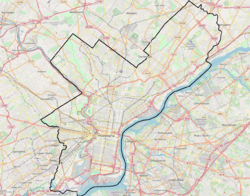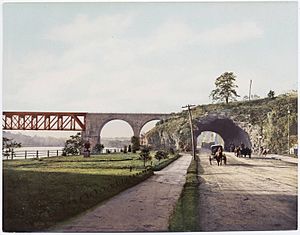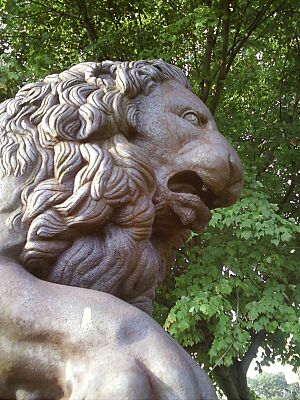Fairmount Park facts for kids
Quick facts for kids |
|
|
Fairmount Park
|
|
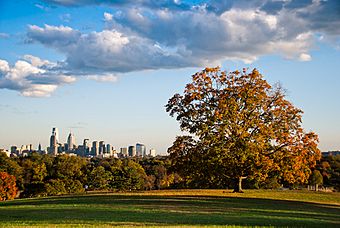
Belmont Plateau view toward Center City
|
|
| Location | Both banks of Schuylkill River and Wissahickon Creek, from Spring Garden St. to Northwestern Ave. in Philadelphia |
|---|---|
| Area | Schuylkill River 2,052 acres (830 ha), Wissahickon Creek 2,042 acres (826 ha) (8.26 square kilometers) |
| Built | 1812 |
| Architect | Robert Morris Copeland; Olmsted & Vaux et al. |
| Architectural style | Colonial Revival, Georgian, Federal |
| NRHP reference No. | 72001151 |
| Added to NRHP | February 7, 1972 |
Fairmount Park is the biggest city park in Philadelphia, Pennsylvania. It's also the old name for a group of parks found all over the city. Today, Fairmount Park mainly means two parts: East Park and West Park. These two parts are separated by the Schuylkill River. Together, they cover about 2,052 acres.
The city department called Philadelphia Parks & Recreation takes care of Fairmount Park. This department was created in 2010. Before 2010, many other city parks were considered part of the "Fairmount Park system." These included Wissahickon Valley Park, Pennypack Park, Cobbs Creek Park, and Franklin Delano Roosevelt Park. But now, these other parks are seen as separate places.
Contents
A Look Back at Fairmount Park
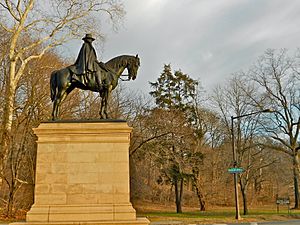
Fairmount Park was Philadelphia's very first park. It covers a large area next to the Schuylkill River. Since 2010, the park is split into East and West Fairmount parks.
The park started with three main areas. These were "South Park," "Old Park" (which included the Lemon Hill and Sedgeley estates), and West Park. West Park is where the Philadelphia Zoo and the Centennial Exposition grounds are. The city bought Lemon Hill and Sedgeley in 1855–56. After the Civil War, more land was added to West Park. In the 1870s, the park also grew to include areas along the Wissahickon Creek. Today, you can find the Schuylkill River Trail in East Park, which is a paved path for walking and biking.
The park is also home to the Belmont Plateau Cross Country Course. This course has hosted big running events, like the USA Cross Country Championships in 1923 and 1976.
How the Park Grew
The park began with the Lemon Hill estate. This land once belonged to Robert Morris, who signed the Declaration of Independence. The city bought Lemon Hill in 1844. It was officially opened to the public in 1855. Over the next few years, the city bought more land. In 1858, a contest was held to redesign Lemon Hill and Sedgeley. This was done to help protect the city's water supply.
Fairmount Park is a very important place. It was the site of the 1876 Centennial Exposition, a huge world's fair. It also has the Philadelphia Zoo, which was the first zoo in the United States. Because of its history, Fairmount Park was added to the National Register of Historic Places in 1972. This list recognizes places important to American history.
What You Can Find in Fairmount Park
Fairmount Park has many interesting places and things to see. These include the Centennial Arboretum, which is like a tree museum. There's also a Horticulture Center where you can learn about plants. Other cool spots are the Fairmount Water Works, Memorial Hall (which now houses the Please Touch Museum), and the Shofuso Japanese House and Garden.
You can also find Boathouse Row, a famous row of historic boathouses along the river. The Smith Memorial Playground and Playhouse is a fun place for kids. The park also has many recreation centers, reservoirs, and beautiful statues.
Art in the Park
Fairmount Park is like an outdoor art museum! It has a large collection of public art. This is thanks to the Association for Public Art. This group was started in 1872 to add sculptures to the park. For example, they helped install the Florentine Lions statues in 1887. The Association still helps create and care for many sculptures in the park. In 2007, they added a large sculpture called Iroquois by Mark di Suvero near the Philadelphia Museum of Art.
Historic Houses in the Park
Fairmount Park is home to many old and beautiful houses. Some of these houses are very old, dating back to the 1700s.
One example is Mount Pleasant, built between 1762 and 1765. The Philadelphia Museum of Art helps manage this house. The museum also cares for Cedar Grove Mansion. This house was built in 1748–50 in another part of the city. It was moved to the park between 1926 and 1928 to save it.
Other historic houses in the park include:
- Boelson Cottage (1678–84)
- The Lilacs (around 1711)
- Letitia Street House (around 1713)
- Ridgeland Mansion (1719)
- Belmont Mansion (1745)
- Woodford Mansion (1756)
- Hatfield House (1760)
- Randolph House (around 1767), now called Laurel Hill Mansion
- Strawberry Mansion (around 1783–89)
- The Solitude (1784–85), located inside the zoo
- Sweetbriar Mansion (1797)
- Ormiston Mansion (1798)
- Lemon Hill Mansion (1800)
- Chamounix Mansion (1802)
- Rockland Mansion (around 1810)
- The Ohio House, built for the 1876 Centennial Exposition.
The Sedgeley Mansion was built in 1799. It was later taken by the city and torn down in 1857. However, a small stone cottage from the Sedgeley property still stands. This cottage was designed by a famous architect named Benjamin Henry Latrobe. It is now known as the Sedgeley Porter's House.
Images for kids
-
Equestrian statue of Ulysses S. Grant by Daniel Chester French and Edward Clark Potter
See also
 In Spanish: Parque Fairmount para niños
In Spanish: Parque Fairmount para niños


